Caravan awnings: a buyers' guide
Caravan awnings are a fantastic addition to any caravan as they are one of the simplest, quickest and most cost-effective ways of adding extra space when your caravan is pitched up on a campsite
Page contents
- Introduction to caravan awnings
- What is the right caravan awning for you?
- Types of caravan awnings
- Caravan awning frames and supports
- Caravan awning fabrics
- Pitching your caravan awning
- Caravan awning warranties
- Final thoughts
- About our magazines
Words by Daniel Attwood
Introduction to caravan awnings
Awnings are a valuable addition to any caravan, offering an extension to living space, and can be used for a variety of purposes – they are basically a tent-like structure that is attached to the side of your caravan, providing extra relaxing, dining, sleeping and storage space once you’re pitched up on a campsite.
In fact, some awnings can more than double your undercover space so they really are worth considering, especially if you tour as a family and/or have kit such as bikes, watersports gear or even just want somewhere undercover for your wet dog and walking gear to dry out.
Indeed, the extra space caravan awnings provide can even offer an extra bedroom or two, a dining area, a food preparation zone and a relaxation area or a combination of all of these things.
Whether you are a seasoned caravan enthusiast or a newcomer to the lifestyle, understanding the basics of caravan awnings can help you choose the right one for your needs. The size of your awning will depend on the size of your caravan, as well as your personal requirements.
Weight is also an important consideration when buying a caravan awning, as you will need to transport your new awning to and from your destination.
Lightweight materials are ideal for this, as they are easy to handle and transport but there are pros and cons with all of these aspects and that’s where we can help make that all-important decision.
Ease of use is also a factor, as you will want to be able to erect your caravan awning quickly and easily, especially if the weather is less than perfect.
Luckily, today’s caravan awnings are designed to be easy to assemble, with clear instructions, which should equal less drama when you’re assembling it.
Caravan awnings and porches are designed for use in different conditions. For example, some are extremely lightweight and speedy to erect, so could be ideal for weekends away or for caravanners who move from campsite to campsite every few days.
Others are made to withstand severe weather and can take longer to erect but will remain a solid structure for weeks or even months; some can even be pitched for an entire season.
Whatever model you choose look for additional features such as heat-reflective roofs and movable pegs that can be clipped onto the awning and moved on a rail so, should you hammer into a rock, simple slide the peg along a little until it is above softer ground.
What is the right caravan awning for you?
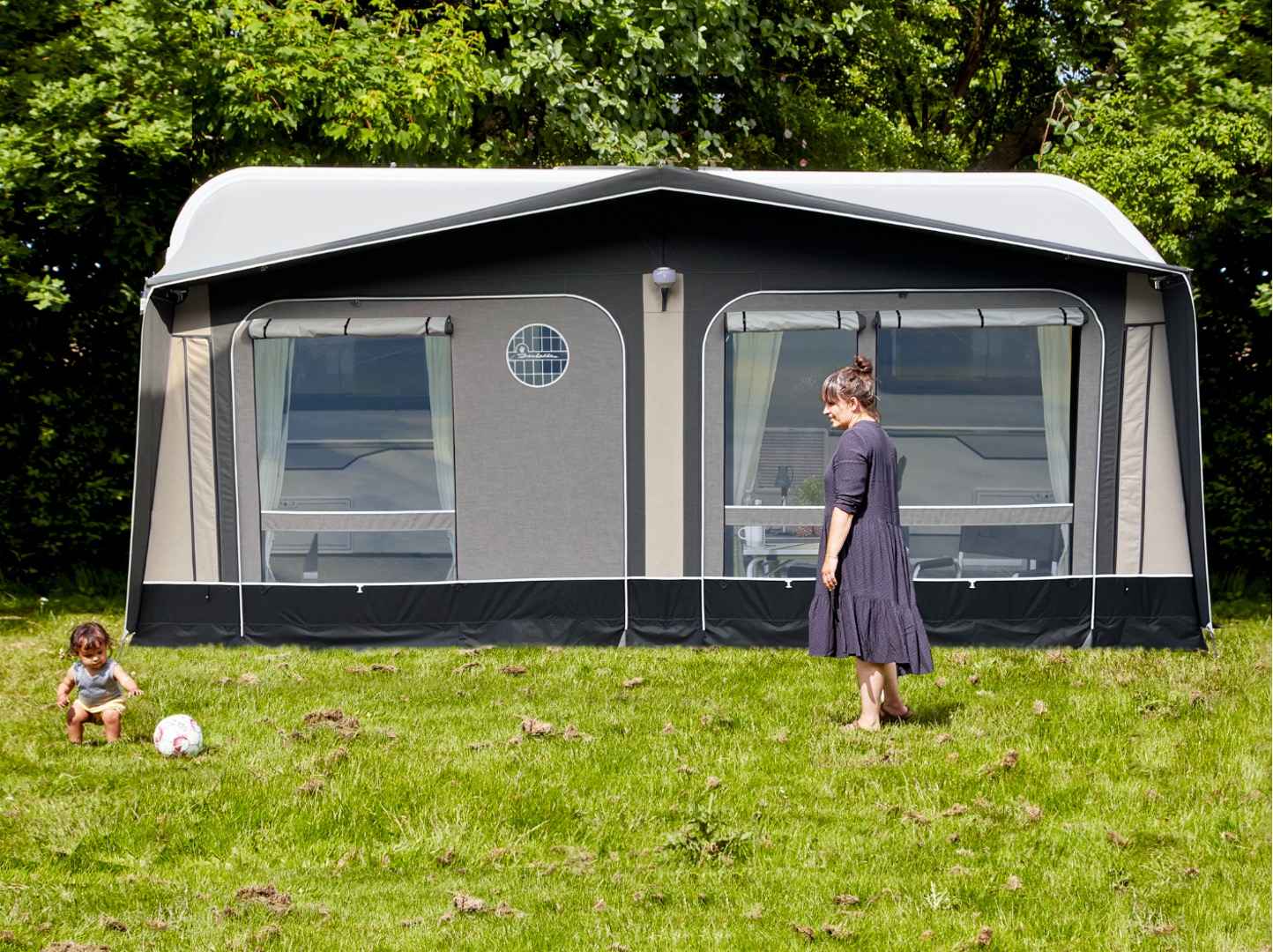
(Photo courtesy of Isabella)
Awnings are not an everyday purchase – they can be a significant and costly investment. If your awning is going to be permanently sited with your caravan for an entire season or if it is used almost every week through the season, then invest in a top-quality model.
If you go for a luxury full awning, for example, you’d be looking at £2,500, depending on the length of your caravan. However, an excellent awning can be found for around £1,500.
At the opposite end of the price spectrum, you can find lightweight, simple porches for as little as £150 for a basic sun canopy. In between those prices is a vast choice and you’ll soon discover there’s an awning or porch to suit every budget and every requirement.
Vango has an augmented reality function you can use to view its awnings in 3D, you can even step inside to gauge the space available. Check it out on your mobile device.
How to measure for a caravan awning
There is some confusion about how you measure for a caravan awning. The simple answer is you measure from the ground up to the start of your awning rail, which will be on the side of the caravan (the same side as the door) at the front corner and then measure all the way around the awning rail to the back corner and then down to the ground again.
It is important not to forget measuring that critical bit from the ground up to the start of the awning rail and back to ground when you get to the other end.
Vango says to make sure the ground is level and that the caravan is level too when it comes to height. It adds that while you can measure alone, it’s much easier with someone to help.
Check out this handy guide here.
Types of caravan awnings
Full caravan awnings
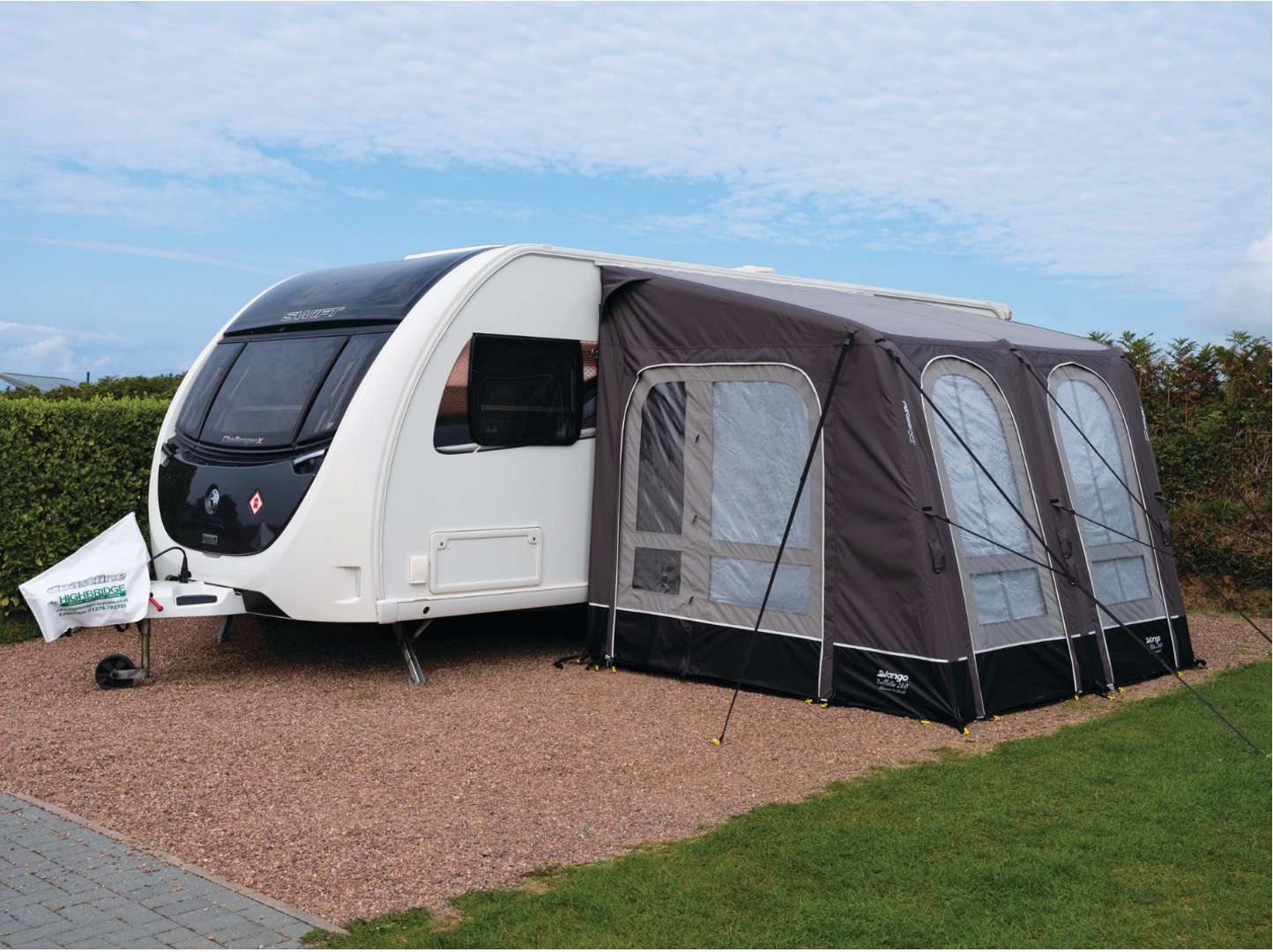
(Photo courtesy of Vango)
These give you maximum space, so they’re ideal for holidays where you are pitched up at the same site for more than just a few days, as well as for permanent pitches.
They take longer to construct than porches, but that’s worthwhile when you’re staying for a week or more. These awnings fit the full length of a caravan from bottom front to bottom rear and are available in many different lengths to accommodate all lengths of caravan. The measurement of full awnings is expressed in centimetres, and what you need depends on the length of your caravan.
Some awning manufacturers have size guides on their websites – just type in the make, model and year of your caravan and up comes the size you need. This can be much easier than trying to figure it all out yourself.
Depending on the model, full-sized awnings can be heavy to handle and transport, which will affect your payload and therefore what else you can carry. If you want to tow with the awning in your caravan, its weight must be subtracted from your payload.
Some seasonal full awnings can weigh 50kg but weights have dropped and now you can get full-sized touring awnings weighing less than half of this.
An example of a high-quality full caravan awning is Isabella’s new Nordic range, which is equipped with Isabella’s heavy-duty MegaFrame, which together with the solid PVC roof makes this a great all-season awning.
The fronts and sides are made of breathable and easy-to-clean Isacryl, while neat touches include flaps for all windows that give extra privacy and protect belongings from the sun's rays. It also has extra-wide entrance doors, which are particularly useful if you have a pram or wheelchair.
It has interchangeable fronts and sides, as well as covered zips that provide protection against damp and UV light.
Caravan porch awnings
Porches are quicker to construct and lighter to transport. A generalisation would be that porches are normally smaller than the full awnings, although some porches can be nearly as large as full awnings.
Porch awnings create a smaller porch area; they are available in fewer sizes but are more universally fitting as they do not cover the full length of the caravan.
The downside is that you don’t have as much space as with a full awning but they suit many caravanners well and the space deficit is outweighed by their lightweight structure, ease of installing and disassembling and their lower cost.
There are longer versions available, Vango’s range of porch awnings, for example, offers 2m models right up to 5m models if your kador channel or awning rail is long enough.
Caravan canopies
Canopies are easy and quick to erect, can stretch the full width of your caravan and can also be permanently fitted so it is just a question of unwinding it for instant cover from the sun or rain.
The downsides are they have no sides so offer no wind protection or privacy and, talking of wind, they can be damaged by strong winds so need to be wound back in should the weather turn too bad. Some canopies can have sides attached to them, making them similar to a full-sized awning.
Caravan awning frames and supports
Awnings are supported on one side by the caravan itself and then by either poles or inflatable air supports. Awning frames come in four types: steel, aluminium, fibreglass and air.
With many awnings on the market you get the option to choose your preferred frame material to suit the use to which you’ll be putting your awning or porch.
Steel-framed caravan awnings
This is a good option if you are planning to leave your awning up for a lengthy period of time, in varying weather conditions. For example, if your caravan is sited for a whole season on the same pitch then go for a poled awning made from quality fabric like TenCate.
Weight isn’t usually a consideration when you’re only transporting your awning to and from a campsite at the start and end of a season. Sometimes you may need additional steel poles for year-round pitching so it remains stable in poor weather when you are not there.
Aluminium and fibreglass-framed caravan awnings
Both of these are lighter-weight options, suitable for touring, when the weight of your awning is a more important consideration in relation to your payload.
When it comes to erecting the awning, both aluminium and fibreglass frames are easier to handle, because each pole is lighter than steel. Aluminium and fibreglass also weather better.
Caravan air awnings
The invention of air technology in awning construction has revolutionised the market and has provided buyers with a new breed of awning that is speedy and easy to construct. The principle behind air awnings is a system of pipework, which you inflate using an upright pump. It’s easy and very quick.
If you’d rather let battery power do the inflation for you, just buy a 12V pump. Air awnings are perfect for those who want an easy-to-pitch awning that is lighter in weight than rigid-poled models.
Vango, more commonly known for its tents, has made significant inroads into the awning market recently, applying its AirBeam technology to a range of full and porch-style awnings. For ease of use, this system has single point inflation; isolation valves mean the air flows into the beams but not back out.
There’s also valves for each beam, which then allow the beams to be topped up when needed and also, when all of these are opened, very quick deflation.
Vango also uses what it calls SuperBeams, which are wider diameter and improve the stability of the awning. Inflation via the company’s Turbo Pump is recommending, with time ranging from two minutes for the smaller two-metre Baletto porches to 6 minutes for a four-metre Tuscany version.
Another example of a new breed of awnings is Bradcot’s Modul-Air range. It can be used as a porch or a full awning – just zip on or zip off the extra segment/s as your requirements change.
Bradcot’s Andy Riley explains,
If you arrive late and it’s raining, you can just put up the porch and then add the rest the next morning
Likewise, when you come to leave, you can take the extensions down the previous day and then the porch on the day you leave. Or, if you’re on a short trip, then just pop up the porch.
Caravan awning fabrics
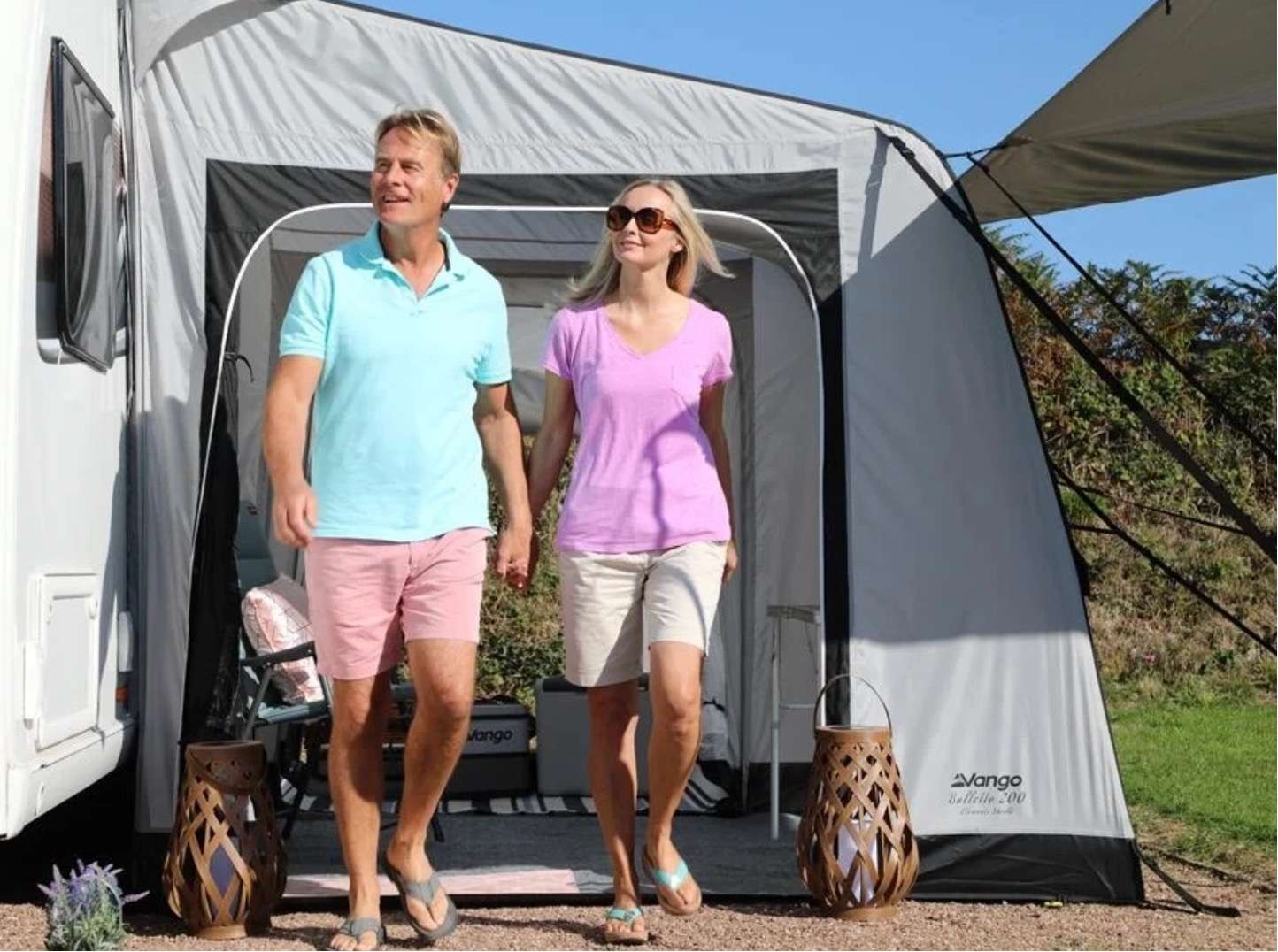
(Photo courtesy of Vango)
Awning fabrics are a critical factor when buying. You want something that dries quickly after rain, that is protected against damaging effects of UV light, that is tough enough to withstand strong winds, and that is both breathable and provides a degree of insulation. It also needs to be lightweight and compact enough to be manageable to carry and transport and then to erect.
The fabrics will vary from lightweight, thin polyester to quality, solution-dyed acrylic and onto the more advanced TenCate fabrics. They can be enormously different in weight, look, feel and quality. And the fabric choice depends on how you’ll use the awning.
Frequent users should invest in a better, more-expensive awning which, typically, will be built to last and is likely to be constructed with TenCate that has a microporous coating, which makes it breathable. Occasional users may struggle to justify such a major expense.
Lightweight polyester has some advantages. It’s quick to dry after rain and light in weight to handle when you’re constructing and packing it away. They’re less expensive than acrylic options but they do not have any breathability or UV protection qualities.
Within this sector, there’s a considerable variation regarding thickness and density of weave, tautness and weight. Expensive, high-quality awnings are made to last many years. They look more taut and rigid than lighter-weight fabrics.
In the acrylic sector, there’s an interesting fabric: fibre-dyed material, also called solution-dyed. In the manufacturing process, the fibres that make up the fabric are dyed before being woven. This fabric is more resistant to the effects of UV light than fabric that has been dyed after it has been made into yarn.
Now, we have TenCate, which is used by the likes of Bradcot and Isabella. Tencate has many advantages and sits at the premium end as it offers extra protection against rain, UV damage and, because it is coated, it allows the fabric to breath so condensation is virtually eliminated.
Whatever the fabric, it best to follow the right steps when packing an awning away.
Pitching your caravan awning
Before buying, be aware of just how heavy and easy or difficult an awning is to erect, especially on a gusty day or if you have no helpers.
Erecting and dismantling an awning is perhaps one of the most daunting aspects of caravanning for a first-timer. This is where air awnings come into their own, especially the latest single-point inflation models.
For more pitching tips, check out this handy step-by-step guide from Caravan Guard.
Caravan awning accessories
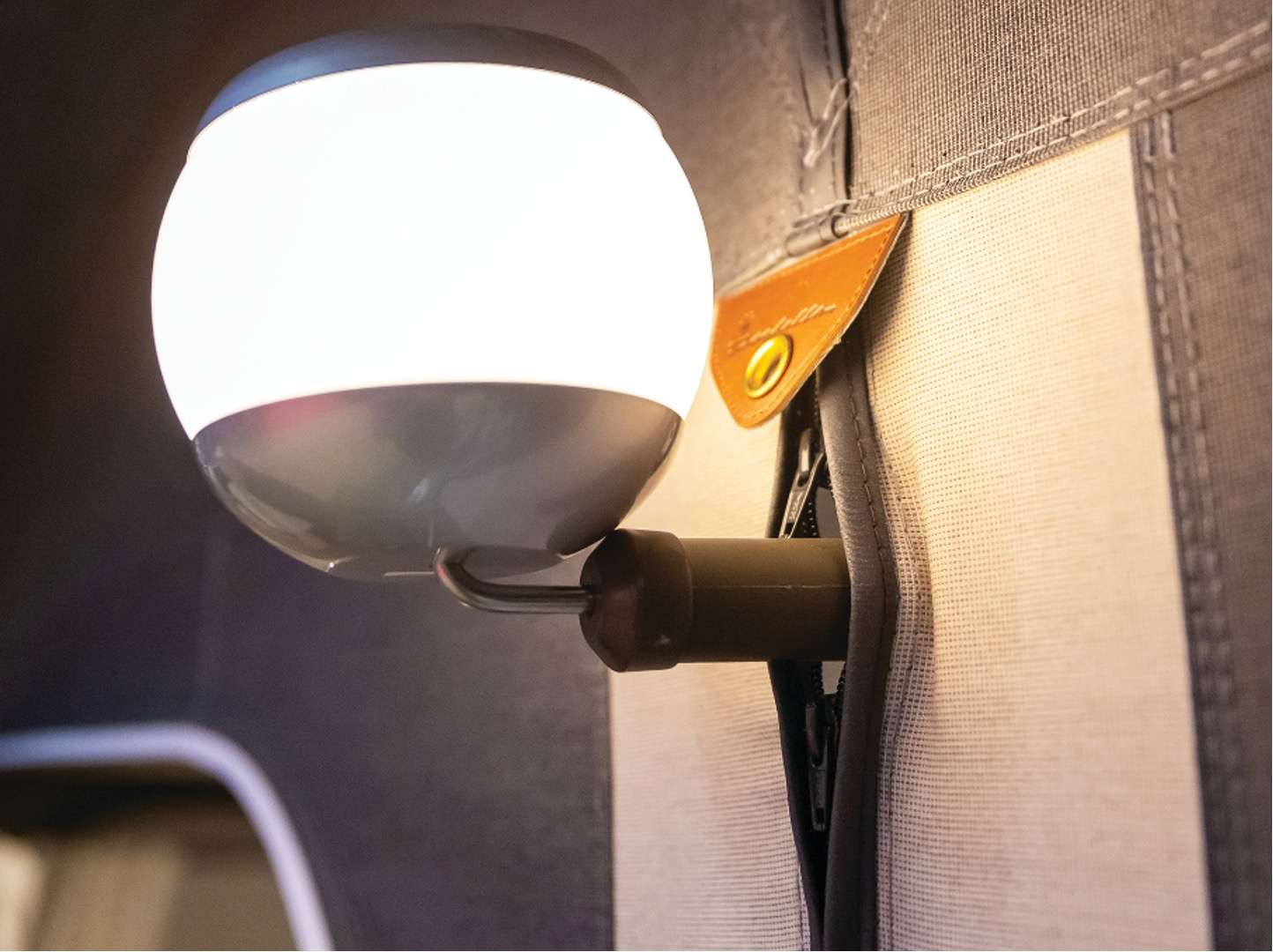
(Photo courtesy of Isabella)
- Lighting: Go for LED lights.
- Carpets, flooring and groundsheets: These all add more comfort, warmth and practicality to the inside of the awning.
- Heating: If you’re a year-round caravanner or even like to pitch up out of season, a safe awning heater can be a great investment for you. Check out our guide to caravan heating systems here.
- Inner tents, privacy rooms and annexes: These are available to make the space inside your awning work better for you.
- Pump for inflatable air awnings: An essential and there are both manual pumps and electric pumps available today.
- Roof liners: Can add extra insulating properties as well as extra protection.
- Additional tent pegs: Pegs, particularly pegs designed for hard ground, are an essential for many, especially if you are not sure of the type of pitch you’re getting.
- Storm straps: Straps are essential for seasonal awnings that are left up for long periods and preferable for those who pitch up when the weather is not on your side.
- Cleaners: These will keep your awning in the best condition for years to come.
Caravan awning warranties
Most good suppliers will offer one to two-year warranty for a new caravan awning.
Vango, for example has a two-year warranty, which can be extended by an extra year if you register online within six months of purchase.
Some manufacturers offer much more and British manufacturer, Bradcot, offers a five-year warranty that covers UV damage.
It says one of the key questions everyone should ask is whether the warranty will cover UV degradation, as some manufacturers do not offer any cover or guarantee against UV degradation.
Caravan awning product reviews
Isabella Nordic
Price: from £3,314 including £886 frame (Nordic 240 A900/G16)
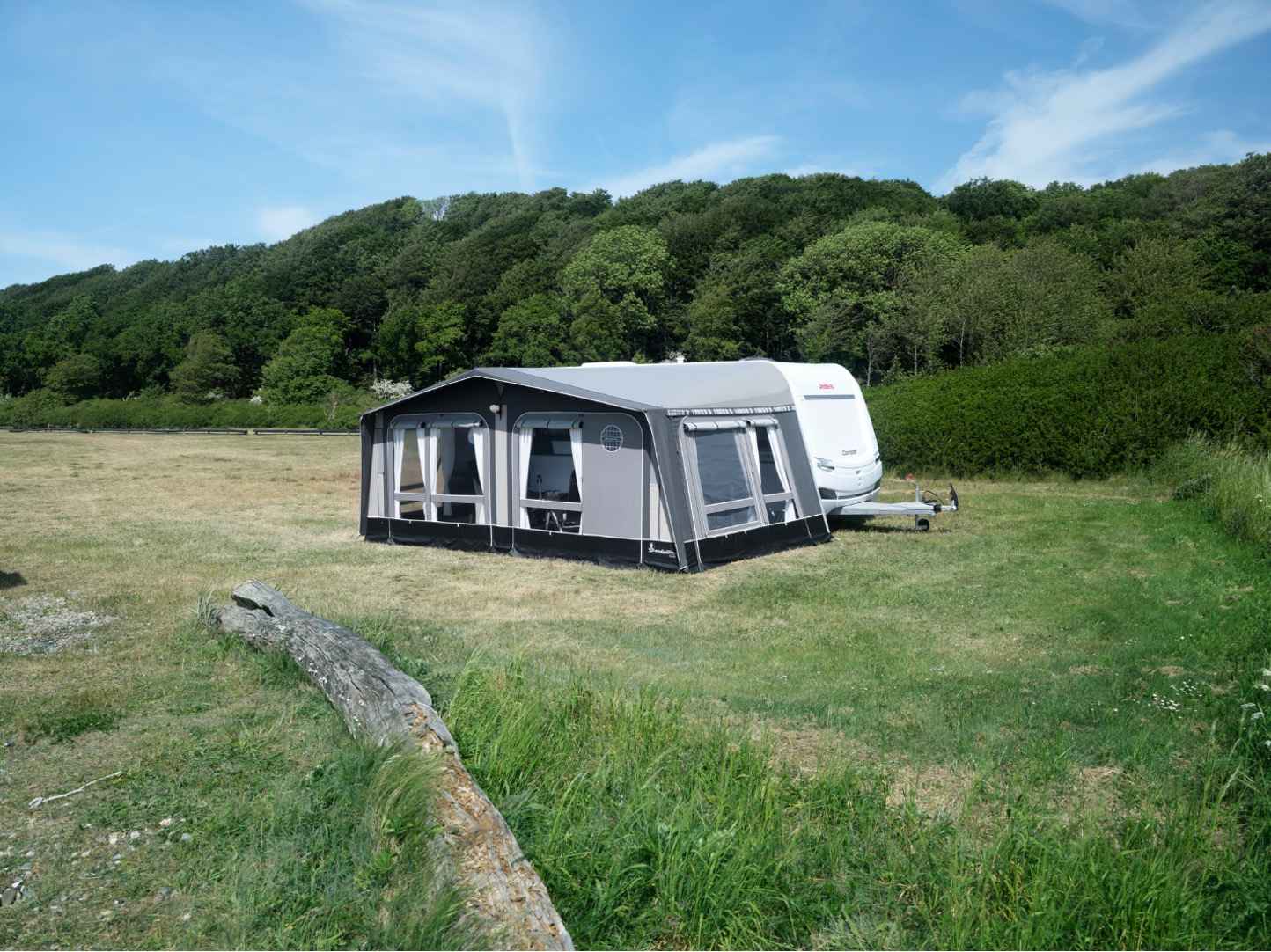
(Photo courtesy of Isabella)
New for the coming season, Isabella’s Nordic range is a full awning that’s been designed for year round use. This combines the company’s heavy-duty MegaFrame and a PVC roof. The Isacryl front and sides are easy to keep clean and offers a degree of breathability.
External blinds for all windows protect the contents from prying eyes and UV damage and an extra wide entrance door is ideal for those with push chairs or wheelchairs. The side skirts are included as standard too, protecting against weather or wind coming into the under from under the caravan.
Choose between a 2.40m or 3m depth in numerous lengths depending on your caravan – in fact there are 50 models in the range. There’s also options for solar lamps and holders as well as annexes and sun canopies.
Vango Touring Awnings
Price: from £680 (Baletto Air 200 Elements Shield)
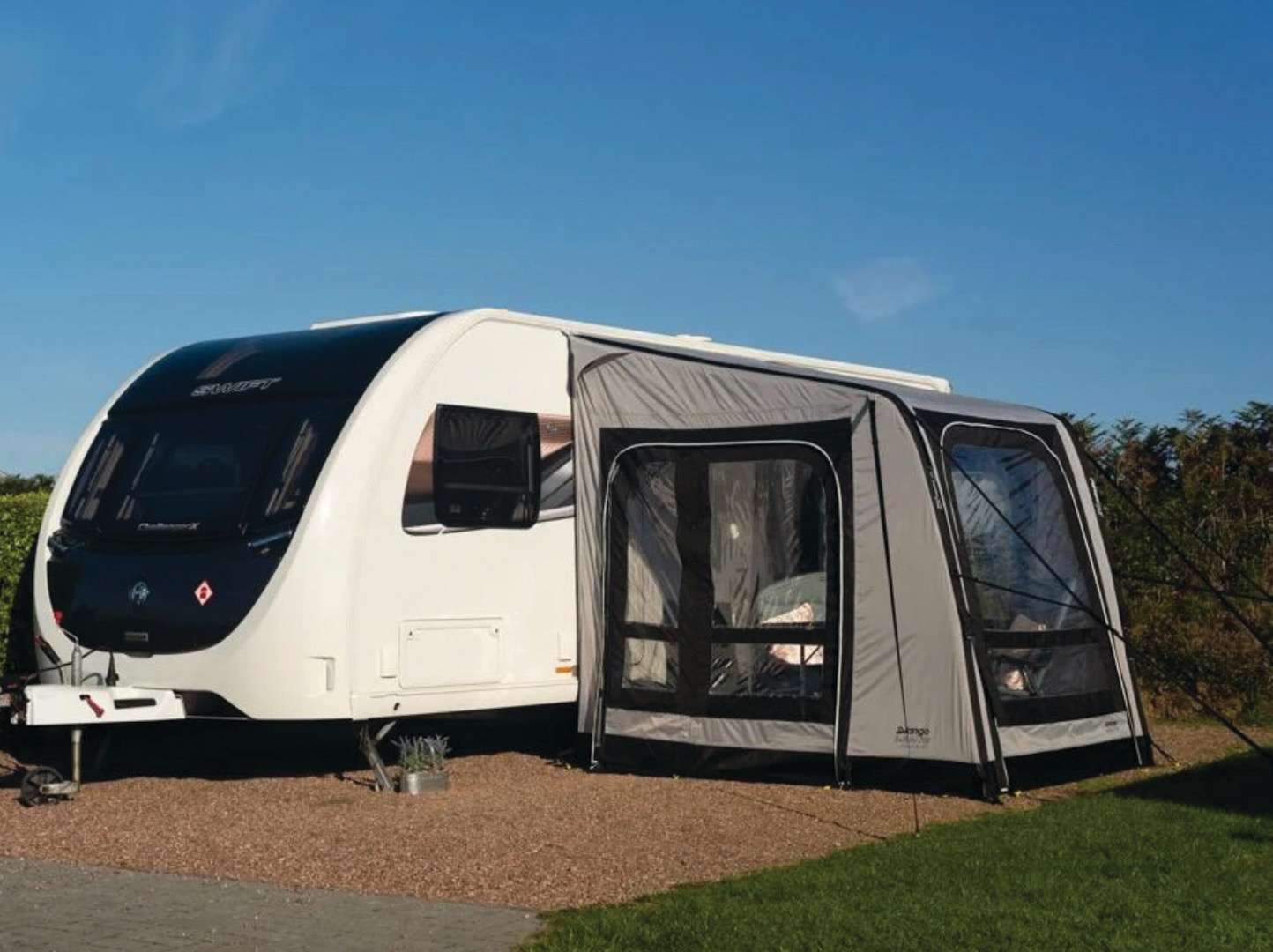
(Photo courtesy of Vango)
This is what you call a porch awning and so does not run the full length of the awning channel. While the price below is for the smallest model in the range, Vango’s porch awnings can be found in lengths of up to 5m.
All models have inflatable frames with single point inflation – fill with air from one central point but you can deflate the tubes (known as beams) individually, allowing for quick take- down procedures.
All awnings come with a draught skirt and two wheel arch covers, storm straps, sky hooks, rock pegs, a manual pump and bracer beams. Vango’s Diamond Clear windows have zipped curtains.
Choose between the lightweight Elements Shield fabric, the slightly heavier duty Elements ProShield with fade resistance features or the top of the range Elements TC fabrics that’s only available on the Riviera 390. You can also add to this with annexes, canopies, carpets and, for easier inflation, Vango’s 12V pump.
Final thoughts
When it comes to choosing the right caravan awning, it is important to do your research and consider your requirements.
Don’t rush in but consider what you will use the awning for and then look for models that best suit your need and budget. We’d always recommend buying from a reputable manufacturer or heading to your nearest dealer with an accessories shop.
Expert Caravan advice to your door!

Caravan magazine has been inspiring caravanners for more than 80 years! We have grown to become a leading authority on caravans, the caravan industry, caravan lifestyle, campsites and caravan travel destinations. We know what our readers want – and that's to make the most of their caravans and their holidays!
Want to know more about Caravan magazine?
About Caravan magazine







Recent Updates
Caravan showers: all you need to know
In this guide, we’ll discuss the different types of showers, how they work, and how to fit an external shower point to your caravan ...
Caravan towing: all you need to know
Towing a caravan may seem daunting initially, but a few simple tips can make the journey enjoyable and ...
All you need to know about towbars & towballs
Flange, detachable, swan neck, retractable – towbar technology choice is bewildering. Don’t worry. We’ll ...
Caravan WiFi: everything you need to know
Caravan holidays are the ultimate way of getting away from it all, although we sometimes need a link to the ...
Caravan insurance: all you need to know
Navigating the world of caravan insurance can feel like a daunting task. Fear not, as this comprehensive ...
Buying a caravan: what you need to know
Let us guide you through some of the complicated things to think about when first looking at buying a ...
Caravan electrics: avoid tripping out
All caravan owners have overloaded their mains supply at some time. Here’s how to master caravan electrics ...
Caravan heating systems: a quick guide to caravanning warmth
When winter is here, you’ll be glad of a decent caravan heating system if you’re out touring. Here’s how the ...
Caravan damp: a complete guide
There's little more guaranteed to strike fear into the heart of a caravan owner than the word 'damp'. But if ...
Caravan jockey wheels: the definitive guide
A well-functioning caravan jockey wheel can make all the difference to manoeuvring away from the towcar, ...
Other Articles
Caravan cooking recipes
Caravan cookery inspirational ideas. No need to stress out in the kitchen with these quick and easy time-saving dishes ...
Caravan bike racks: a complete guide
Exploring the beautiful surroundings while on a caravan trip is undeniably one of the greatest joys of the ...
A guide to solar power in your caravan
Not that many years ago, mains electrical hook-up on campsites was considered a bit of a luxury, and, for ...
The ultimate guide to caravan layouts
Choosing the right layout or floorplan of your caravan is an all-important part of the buying process – find ...
A guide to seasonal caravan pitches
Our in-depth guide to finding and securing seasonal caravan pitches on your favourite campsite ...
Caravan weights and payloads: a quick guide
The terminology of caravan weight – MIRO, MTPLM, noseweight, kerbweight, payload, weight plate upgrade – is ...
The ultimate guide to caravan motor movers
Caravan motor movers: everything you need to know about remote control caravan manoeuvring ...
Caravan cleaning: All you need to know
Whether you’re taking the caravan out for the first time or it’s just in need of a spruce up, our guide will ...
18 essential items for camping with your dog
Camping is for the whole family – including our four-legged members. Here's what you'll need to keep your dog ...
14 welly boots for camping trips
It might be April but that won’t stop the rain in the UK, so a pair of comfortable welly boots is still ...